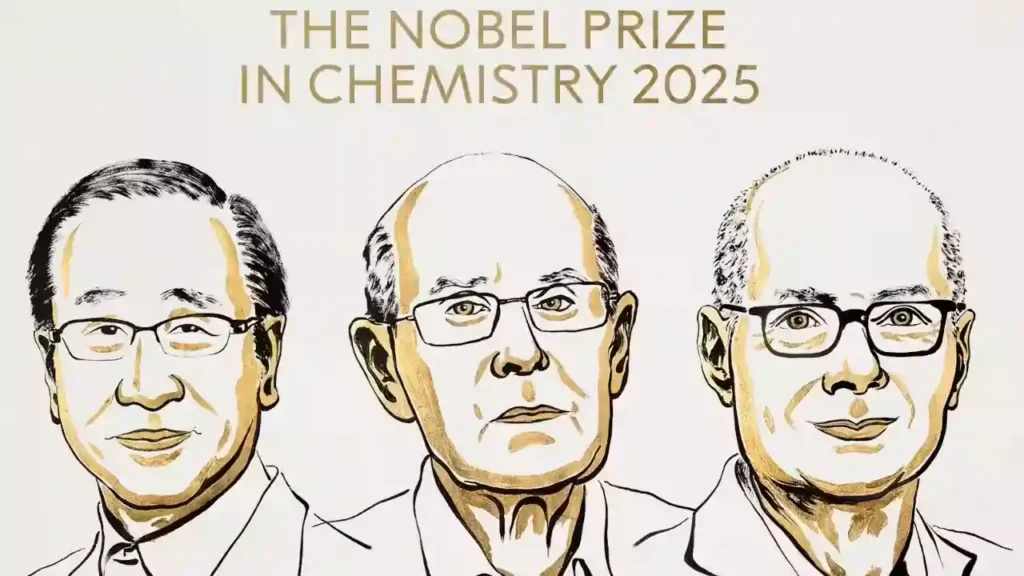New Delhi: The Royal Swedish Academy of Sciences has named Susumu Kitagawa, Richard Robson, and Omar M. Yaghi as the recipients of the 2025 Nobel Prize in Chemistry, honoring their pioneering development of Metal-Organic Frameworks (MOFs). This innovative molecular architecture has revolutionized chemistry, offering solutions to critical global challenges such as climate change, water scarcity, and pollution. Representing Japan, Australia, and the United States, the trio will share the 11 million Swedish crowns (approximately $1.2 million) prize, recognizing their transformative contributions that have led to the creation of tens of thousands of MOF variants.

Decoding Metal-Organic Frameworks
Metal-Organic Frameworks, or MOFs, are remarkable materials that encapsulate vast internal spaces within compact structures, akin to the fictional handbag of Hermione Granger from the Harry Potter series, which holds far more than its size suggests. A mere gram of MOF material can possess an internal surface area equivalent to a football pitch due to its intricate network of pores. These pores serve as microscopic chambers, selectively capturing, separating, or transforming gases, ions, and other molecules, functioning like molecular hotels with carefully designed entry points.
MOFs are constructed from metal ions interconnected by organic, carbon-based molecules, forming a three-dimensional lattice with spacious, customizable cavities. The ability to modify the metal and organic components allows scientists to tailor the size and shape of these pores to target specific substances, making MOFs exceptionally versatile for a wide range of applications.
Far-Reaching Applications of MOFs
The Nobel Committee praised MOFs for their potential to address humanity’s most urgent challenges. Their applications span environmental, industrial, and medical fields:
- Water Harvesting: MOFs can absorb water vapor from desert air during cooler nighttime hours and release clean, drinkable water under morning sunlight, providing a lifeline for water-scarce regions.
- Pollution Remediation: These frameworks excel at filtering out persistent contaminants like Perfluoroalkyl and Polyfluoroalkyl Substances (PFAS), often called “forever chemicals.” They also catalyze the decomposition of crude oil residues and antibiotics in polluted water, supporting environmental restoration.
- Industrial Innovations: MOFs enable the extraction of rare-earth elements from wastewater, advancing sustainable mining. They facilitate hydrogen storage for clean energy systems and capture carbon dioxide to combat climate change. In cement production, which accounts for 7% of global CO2 emissions, MOFs are already being used at select facilities to trap emissions before release.
- Medical Advancements: MOFs support precise delivery of pharmaceuticals within the human body, safely manage highly toxic gases, and encapsulate enzymes that break down antibiotic residues in the environment, helping to curb antimicrobial resistance.
Following the foundational work of Kitagawa, Robson, and Yaghi, chemists have developed tens of thousands of MOF variants. These structures hold promise for addressing critical issues, such as removing toxic PFAS from water supplies and neutralizing pharmaceutical traces in ecosystems, as noted by the Academy.
The Laureates: Journeys of Passion and Perseverance
The 2025 Chemistry laureates bring unique personal stories to their shared achievement:
- Susumu Kitagawa, a professor at Kyoto University, Japan, expressed deep honor at receiving the award. He shared his ambitious vision: “My dream is to capture air and separate it into—for instance, CO2, oxygen, or water—and convert this to useful materials using renewable energy.” His work highlights MOFs’ potential to drive sustainable resource solutions.
- Richard Robson, a British-born professor at the University of Melbourne, Australia, learned of the award just 30 minutes before its public announcement. Celebrating modestly at his home near Melbourne, he cooked a fish dinner with his wife, washed the dishes, and toasted with a glass of inexpensive wine, breaking a recent health-related pledge to avoid alcohol. “I broke that rule by having a glass of very cheap wine,” he shared with a smile.
- Omar M. Yaghi, a Jordanian-American professor at the University of California, Berkeley, was born to Palestinian refugees in Jordan, growing up in a single-room home shared with livestock. His parents had limited literacy, but at age 10, Yaghi discovered a book on molecules that sparked his lifelong passion for chemistry. “Science is the greatest equalizing force in the world,” he reflected, emphasizing the journey from his humble beginnings to global recognition. He underscored MOFs’ practical impact, particularly in carbon capture for cement production, stating, “I don’t see that as hype, that is an implementation of science, basic science, all the way to benefiting society.”
Yaghi’s fascination with molecular structures deepened over time: “The deeper you dig, the more beautifully you find things that are constructed,” he noted, capturing the essence of his dedication.
The Nobel Legacy: Celebrating Scientific Milestones
The Chemistry prize marks the third announcement in the 2025 Nobel series, following awards in medicine and physics earlier this week. The literature prize will be revealed on Thursday, followed by the peace prize on Friday. On December 10, commemorating the anniversary of Alfred Nobel’s death, the laureates will receive their medals from the Swedish king in a formal Stockholm ceremony.
Founded in 1901 through Alfred Nobel’s will, the Nobel Prizes recognize excellence in science, literature, and peace, with economics added later. Nobel, a chemist whose invention of dynamite generated his wealth, ensured chemistry remained a cornerstone of the awards. Though sometimes less publicized than physics or peace prizes, chemistry honors have celebrated transformative discoveries like nuclear fission and DNA sequencing. In 2024, U.S. scientists David Baker and John Jumper, alongside Britain’s Demis Hassabis, were recognized for advancing protein structure prediction, impacting drug development.
Olof Ramstrom, a member of the Nobel Committee for Chemistry, highlighted MOFs’ “unheard of properties,” noting that a sugar-cube-sized sample could match a football pitch’s surface area. He emphasized their ability to store vast amounts of gas, underscoring their role in addressing climate change and freshwater shortages.
A Future Shaped by Molecular Innovation
The contributions of Kitagawa, Robson, and Yaghi have redefined the possibilities of molecular science. From harvesting water in arid regions to capturing carbon in industrial settings, MOFs provide practical solutions to pressing global challenges. Their 2025 Nobel recognition validates decades of meticulous research while inspiring future scientists to explore new molecular frontiers.
Yaghi’s view of science as an equalizing force resonates profoundly, demonstrating how determination and curiosity can transcend modest origins. Robson’s quiet celebration reflects the understated commitment behind groundbreaking discoveries. Kitagawa’s vision for renewable energy applications points to a sustainable future powered by MOFs.
As humanity grapples with environmental and health crises, MOFs stand as a beacon of hope. Whether purifying water, advancing clean energy, or delivering life-saving drugs, these frameworks are transforming industries and protecting the planet. The 2025 Nobel Prize in Chemistry celebrates a scientific milestone that paves the way for a brighter, more sustainable world.
FAQs
1. Who won the 2025 Nobel Prize in Chemistry, and why were they awarded?
The 2025 Nobel Prize in Chemistry was awarded to Susumu Kitagawa (Kyoto University, Japan), Richard Robson (University of Melbourne, Australia), and Omar M. Yaghi (University of California, Berkeley, USA) for their pioneering development of Metal-Organic Frameworks (MOFs). These innovative molecular structures have vast internal surface areas and customizable pores, enabling applications like water harvesting, pollution control, and carbon capture, addressing global challenges such as climate change and water scarcity.
2. What are Metal-Organic Frameworks (MOFs), and how do they work?
MOFs are advanced materials made of metal ions linked by organic, carbon-based molecules, forming a three-dimensional network with large, porous cavities. These pores act like tiny molecular chambers that can selectively trap, separate, or transform gases, ions, and other molecules. A single gram of MOF can have an internal surface area as large as a football pitch, making them highly effective for storing or processing substances in small volumes.
3. What are some practical applications of MOFs?
MOFs have diverse applications, including:
Healthcare: Delivering pharmaceuticals precisely in the body, managing toxic gases, and neutralizing environmental antibiotic residues.
Water Harvesting: Capturing water vapor from desert air at night and releasing potable water in morning heat.
Pollution Remediation: Filtering out “forever chemicals” like PFAS and breaking down crude oil or antibiotics in contaminated water.
Industrial Uses: Extracting rare-earth elements from wastewater, storing hydrogen for clean energy, and capturing carbon dioxide in industries like cement production.
4. How have MOFs impacted scientific research and global challenges?
The work of Kitagawa, Robson, and Yaghi has led to the creation of tens of thousands of MOF variants, each tailored for specific purposes. These frameworks provide chemists with tools to tackle pressing issues like climate change, water scarcity, and pollution. For example, MOFs are used in cement plants to capture CO2 emissions, contributing to efforts to reduce the 7% of global carbon dioxide emissions from this industry, and they help purify water by removing harmful substances.
5. What makes the 2025 Nobel Prize in Chemistry significant?
The 2025 Nobel Prize in Chemistry highlights the transformative power of fundamental scientific research. MOFs demonstrate how molecular innovation can address real-world problems, from environmental sustainability to medical advancements. The recognition of Kitagawa, Robson, and Yaghi underscores the global impact of their work and inspires future research to solve humanity’s greatest challenges, reinforcing science’s role as a force for progress and equality.

